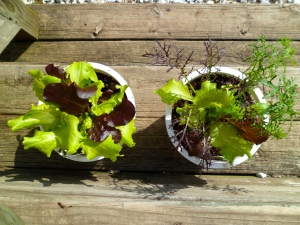Well, we have reached May, with May temperatures – high 60’s to mid 70’s during the day and mostly 50’s at night.
There are now soooo many things to write about with regard to spring gardening. Where to start…where to start? I am going to start with tomatoes. So many people have been picking up their plants and this may help answer some questions and get things off to a good start.
There are a couple of terms floating around out there: indeterminate, determinate, and heirloom.
Indeterminate varieties set tomatoes over several months, while determinate varieties product their fruits heavily over a very short period of time. Heirloom varieties are tomatoes that have not been hybridized and have been cultivated for at least 50 years or more. A good example of an heirloom variety is the Brandywine tomato, an Amish tomato that dates back to 1885.
Generally there are different types of tomatoes: bush tomatoes, cherry & grape tomatoes, plum tomatoes, vining tomatoes, and even intermediate bush/vining.
Where to plant: In a full sun area, and in a spot where you haven’t grown tomatoes in the previous two years. This type of crop rotation prevents plants from falling prey to any build up of tomato diseases in the soil. Be sure to give your plants plenty of space to grow. They may be small when you bring them home but boy do they get big pretty quickly. It is best to follow the spacing instructions listed on the plant tag.
Plant your tomatoes by digging a hole about two times bigger than the root ball and about 12″ deep.This loosens the soil and allows for quicker root development. With the soil, mix in well-rotted compost, manure, or some type of higher phosphorous fertilizer, (Espoma’s Triple Phosphate is a great choice). Water your plants thoroughly but from that point further, it is best to water little and often, ensuring that the soil and roots never dry out. ****Be careful to not get into the habit of flooding them when you water. Do not begin to fertilize the tomatoes until flowers begin to form on the plants. Use a tomato/vegetable fertilizer to be sure that they are getting the right formulation, (again, Espoma Tomato-Tone or Garden-Tone are two reliable choices).
If you are planting your tomatoes in containers, choose a pot that has drainage and is at least 14″ in diameter – larger is even better. Follow the care instructions previously discussed but as for a potting mix, use soil that states that it is suitable for vegetable potting.
Tomato Growing Part 2 will be following, as I add my own garden additions.
 The calendar insists that the first day of summer is June 21, but all of us know that summer actually begins on Memorial Day! Swimming pools are open and outdoor furniture is cleaned up and ready to use for the first big barbecue or back yard cook out. If the cooler temperatures keep you out of the pool, they are certainly perfect temperatures for gardening.
The calendar insists that the first day of summer is June 21, but all of us know that summer actually begins on Memorial Day! Swimming pools are open and outdoor furniture is cleaned up and ready to use for the first big barbecue or back yard cook out. If the cooler temperatures keep you out of the pool, they are certainly perfect temperatures for gardening.









